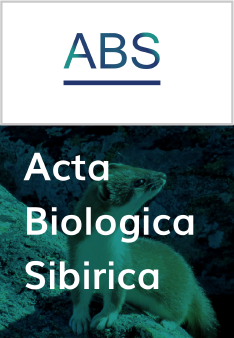Abstract
The composition of fatty acids in the general lipid balance of Dracocephalum palmatum Steph. Ex Willd that is found in extreme climatic conditions (Northern Pole of Cold) was researched by thinlayer and gas-liquid chromatography. This research aims to study the fatty acid profile of the perennial species Dracocephalum palmatum used as a medicinal herb in traditional medicine. We established that polyunsaturated fatty acids [FA], and more specifically linoleic and alpha-Linoleic acids, are prevalent in the lipidic constitution. The exceptional resilience of arctic and boreal plants is attributed to their flexible energy system that includes carbohydrates, proteins, and lipids. The latter are crucial in the energy balance of plants because they function as the main accumulator of spare energy and can create optimal conditions in cell membranes, unlike carbohydrates and proteins. Polyunsaturated fatty acids [PFA] present in the lipid layer allow the membranes to stay in the liquid state. Fat oxidation releases an amount of water that is considerably greater than that released by the combustion of carbohydrates and proteins. This research reveals that the fluidity of membranes in the arctic plant in question is optimal due to a high level of unsaturated lipids. The high amount of unsaturated FA in Dracocephalum palmatum lipids is attributed to the plant adapting to its poor growing conditions. We assume that late flowering plants with a higher than average level of PFA (linoleic and linolenic acids) higher than average play an important role in the conservation of reaction energy resources of animals in the northern environment.
References
Christie WW (1993) Preparation of ester derivatives of fatty acids for chromatographic analysis. Advances in Lipid Methodology 2 (69): 69–111.
Imbs AB (2012) Lipids and fatty acids of Vietnam corals: Composition, chemotaxonomic significance, possible ways of biosynthesis and transmission between symbionts and the host organism. Thesis for the degree of Doctor of Biological Sciences. A.V. Zhirmunsky Institute of Marine Biology of the Russian Academy of Sciences, Vladivostok.
Jahns P, Holzwarth AR (2012) The role of the xanthophyll cycle and of lutein in photoprotection of photosystem II. Biochimica et Biophysica Acta (BBA) – Bioenergetics 1817 (1): 182–193. https://doi.org/10.1016/j.bbabio.2011.04.012
Kirichenko KA, Pobezhimova TP, Kazanovsky SG, Sokolova NA, Kondratyeva ES, Grabelnykh OI, Voinikov VK (2019) Comparative analysis of the fatty acid composition of coastal aquatic Typha latifolia, submerged Ceratophyllum demersum, and the water form Veronica anagallis-aquatica of the water bodies of the Baikal region. Khimija Rastitel'nogo Syr'ja 4: 119–128. https://doi.org/10.14258/jcprm.2019045155 [In Russian]
Lee S-E, Okhlopkova Z, Lim C, Cho S (2020) Dracocephalum palmatum Stephan extract induces apoptosis in human prostate cancer cells via the caspase-8-mediated extrinsic pathway. Chinese Journal of Natural Medicines 18 (10): 793–800. https://doi.org/10.1016/S1875-5364(20)60019-X
Los DA (2014) Fatty acid desaturases. Scientific World, Moscow, 372 pp. [In Russian]
Luckey M (2014) Membrane Structural Biology: With Biochemical and Biophysical Foundations. Cambridge University Press, London, 423 pp.
Malyshev LI, Peschkova GA (2006) Flora of Siberia. Vol. 11. Pyrolaceae - Lamiaceae. Science Publishers, Novosibirsk, 310 pp. https://doi.org/10.1201/9781482279696
Olennikov DN, Chirikova NK, Okhlopkova ZM, Zulfugarov IS (2013) Chemical composition and antioxidant activity of Tánara Ótó (Dracocephalum palmatum Stephan), a medicinal plant used by the North-Yakutian nomads. Molecules 18 (11): 14105–14121. https://doi.org/10.3390/molecules181114105
Olennikov DN, Chirikova NK (2015) Dracopalmaside, a new flavonoid from Dracocephalum palmatum. Chemistry of Natural Compounds 6: 1067–1069. https://doi.org/10.1007/s10600-015-1493-3
Olennikov DN, Chirikova NK, Kashchenko NI, Gornostai TG, Selyutina IYu, Zilfikarov IN (2017) Effect of low temperature cultivation on the phytochemical profile and bioactivity of Arctic plants: A case of Dracocephalum palmatum. International Journal of Molecular Sciences 12: 2–29. https://doi.org/10.3390/ijms18122579
Petrov KA (2016) Cryoresistance of Plants: Ecological, Physiological and Biochemical Aspects. Siberian Branch of the Russian Academy of Sciences, Novosibirsk, 273 pp.[In Russian]
Sofronova VE, Petrov KA, Dymova OV, Chepalov VA, Golovko T (2019) Fund of green and yellow pigments in spring oats cultivated for cryo-feed in Central Yakutia. Agrarian Bulletin of the Urals 4 (183): 72–77. https://doi.org/10.32417/article_5cf9fc0d9620d9.91729225 [In Russian]
Song E, Choi J, Gwon H, Lee K-Y, Choi S-G, Islam MA, Chun J, Hwang J (2021) Phytochemical profile and antioxidant activity of Dracocephalum moldavica L. seed extracts using different extraction methods. Food Chemistry 350: 128531. https://doi.org/10.1016/j.foodchem.2020.128531
Acta Biologica Sibirica is a golden publisher, as we allow self-archiving, but most importantly we are fully transparent about your rights.
Authors may present and discuss their findings ahead of publication: at biological or scientific conferences, on preprint servers, in public databases, and in blogs, wikis, tweets, and other informal communication channels.
ABS allows authors to deposit manuscripts (currently under review or those for intended submission to ABS) in non-commercial, pre-print servers such as ArXiv.
Authors who publish with this journal agree to the following terms:
- Authors retain copyright and grant the journal right of first publication with the work simultaneously licensed under a Creative Commons Attribution License (CC BY 4.0) that allows others to share the work with an acknowledgement of the work's authorship and initial publication in this journal.
- Authors are able to enter into separate, additional contractual arrangements for the non-exclusive distribution of the journal's published version of the work (e.g., post it to an institutional repository or publish it in a book), with an acknowledgement of its initial publication in this journal.
- Authors are permitted and encouraged to post their work online (e.g., in institutional repositories or on their website) prior to and during the submission process, as it can lead to productive exchanges, as well as earlier and greater citation of published work (See The Effect of Open Access).





